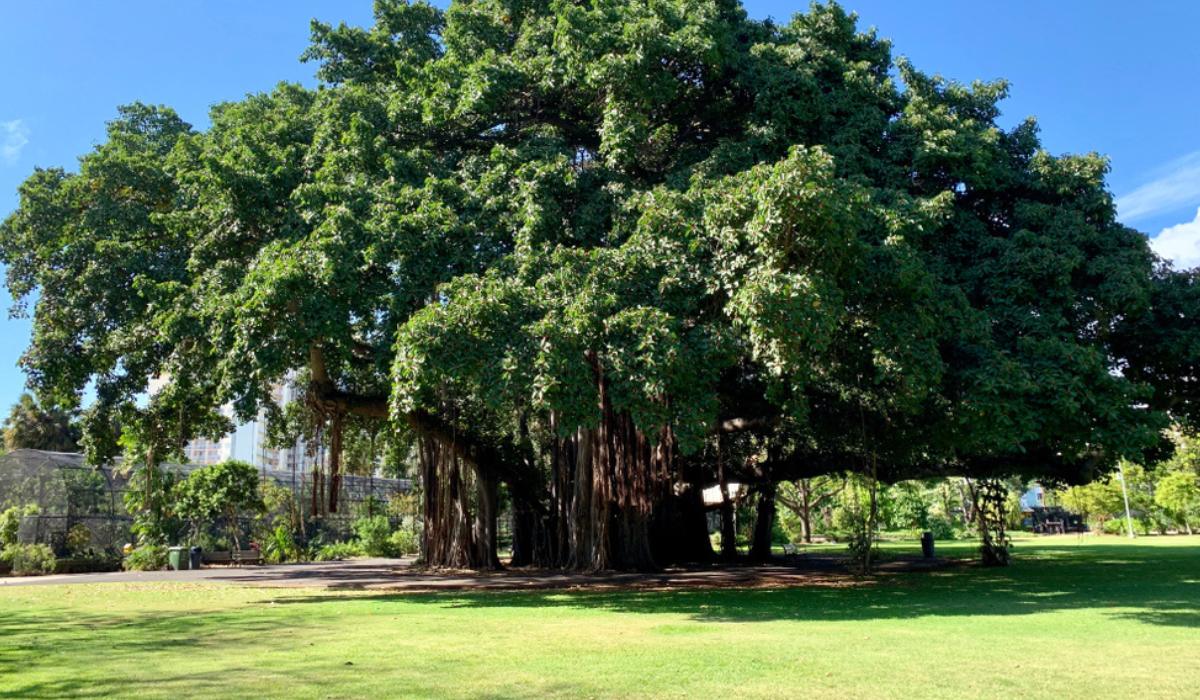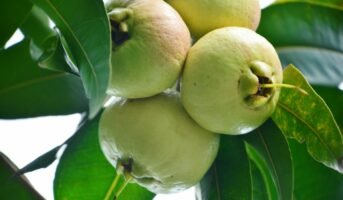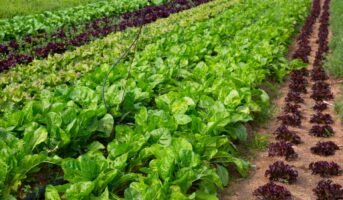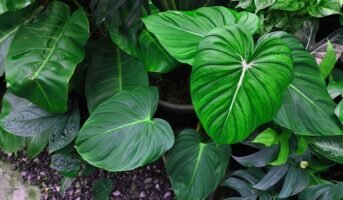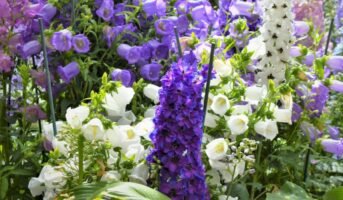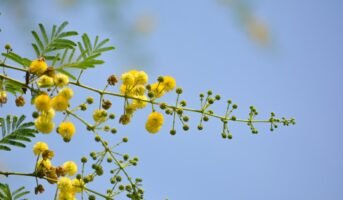A banyan, frequently written “banian,” is a type of fig that grows auxiliary trunks from accidental prop roots, enabling the tree to grow endlessly. It sets banyans apart from other trees with a strangling habit that emerges from their seed in a crack. The term “banyan” is frequently used to refer exclusively to Ficus benghalensis, also known as the “Indian banyan,” which is the national tree of India. However, it has also been used systematically to refer to the subgenus Urostigma.
Banyan tree characteristics
Like other fig species, Banyans produce their fruit in a structure known as a “syconium.” Fig wasps find food and shelter in the syconium of Ficus species, and the trees rely on the wasps to pollinate them. Frugivorous birds disperse banyan seeds. The seeds are tiny, and since most banyans are found in wooded areas, a seedling that sprouts on the ground has little chance of surviving.
However, many seeds land on the stems and branches of other trees or artificial structures. When they germinate, they sprout roots that spread outward and may eventually encircle a portion of the host tree or system. This behavior, also referred to as a “strangler,” is shared by a variety of tropical Ficus species and several species from unrelated genera, including Clusia and Metrosideros. The banyan tree has broad, elliptical, leathery, glossy, green leaves and two large scales protecting the leaf bud of most figs. Scales abscise as the leaf grows. As a result, the young leaves have a lovely scarlet tint. Older banyan trees can be identified by their prop roots, which develop into thick, woody trunks that, with time, may resemble the main stem.
These support roots enable older trees to spread across a wide area to grow laterally. Some species’ prop roots grow over a sizable region resembling a grove of trees, with each trunk attached directly or indirectly to the main compartment. The hierarchical computer network operating system takes its name from the topology of this enormous root system. The mesh of roots that forms around the host tree in a banyan that envelops it eventually exerts significant strain on it and frequently kills it. The banyan eventually decomposes into a “columnar tree” with a hollow central core due to being encircled and dying. Such hollows are highly sought-after homes for many species in jungles.
Banyan tree classification
Ficus benghalensis, the original banyan, can develop into a massive tree that occupies many hectares. The term was eventually applied to all Urostigma subgenus strangler figs. The several species of banyan also include: Ficus microcarpa is a significant invasive species in other parts of the world and is native to Pakistan, Nepal, India, Bangladesh, Sri Lanka, Bhutan, Taiwan, China, the Malay Archipelago, mainland Australia, Southeast Asia, New Guinea, Ryukyu Islands, and New Caledonia. Native to Central America and northern South America, from southern Mexico south to Paraguay, the Central American banyan (Ficus pertusa) is a large tree. South Florida, the Caribbean, Central America, and South America south of Paraguay are the native home of the shortleaf fig (Ficus citrifolia).
See also: All about Cypress Vine
Banyan tree: Significance as per religion and mythology
Many Asian and Pacific tales and religions include banyan trees prominently, including:
- Numerous references to the banyan may be found in Buddhism’s Pali canon.
- In Vietnamese mythology of the Mid-Autumn Festival, the dark markings on the Moon are a banyan, a magical tree initially planted by a man named Cuội on Earth. The man was hanging on the tree when his wife watered it with dirty water. The tree then uprooted itself and soared to the Moon, where he now lives internally with the Moon Lady and the Jade Rabbit.
- They are known as balete trees in the Philippines and are the residence of some gods and spirits.
- They are known as balete trees in the Philippines and are the residence of some gods and spirits.
- The tree, known as gajumaru in Okinawa, is said to be the abode of the legendary Kijimuna in local folklore.
- The Chamorro people of Guam hold beliefs in legends involving taotaomona, duendes, and other spirits. Banyan trees are protected by the ancient Chamorro spirits known as Taotaomona.
Historical banyan trees
- A banyan tree named Thimmamma Marrimanu may be found near Anantapur, which is about 35 kilometers from Kadiri in the Indian state of Andhra Pradesh. It can be found in the Indian Botanical Gardens, where it has been growing for more than 550 years and has a 19,107 m2 canopy (4.721 acres)
- The Great Banyan, one of the most significant trees, can be located in Kolkata, India. It is said to be older than 250 years and has a 4.67-acre footprint.
- Another such tree, Dodda Alada Mara, often known as the “Big Banyan Tree,” may be located in the Indian village of Ramohalli, some 2.5 acres outside of Bangalore.
- The banyans at Hawaii’s Iolani Palace. Two banyan trees were planted on the grounds of Iolani Palace by Queen Kapiolani in the 1880s. These trees have grown into substantial clusters on the grounds of the former historic palace.
- William Owen Smith planted the banyan tree at Lahaina’s Courthouse Square in Maui, Hawaii, in 1873. It has expanded to occupy a two-thirds-acre area.
- Kalpabata, a sizable banyan tree, is located on the grounds of Puri’s Jagannath Temple. It is considered sacred by the followers and is thought to be older than 500 years.
- There is a sizable banyan tree in Cypress Gardens at the Legoland theme park in Winter Haven, Florida. It was sown in a 5-gallon pail in 1939.
How the Banyan tree proliferates and grows?
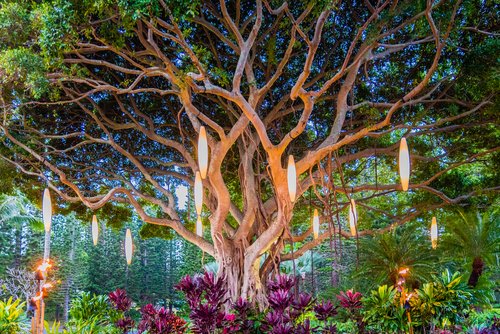
There are numerous species of fig trees, and most of them—including the Banyan tree – are strangulated. When a seed from a foraging mammal or bird survives on a nearby tree branch, often known as the host tree, the process is said to have begun.
The seed grows roots that eventually spread out and round the host tree’s trunk. The roots tangle and interlock with the host’s trunk to create a barrier restricting the box and making it compete with the sources for nutrients. Sometimes, this territorial invasion results in the host tree’s death. Because of this, the growing banyan tree resembles a vast root system rather than a typical tree trunk.
What height can a Banyan tree reach?
The banyan grows in lateral directions and can reach heights up to 100 feet. One tree can eventually start to resemble a small forest.
Banyan trees: Therapeutic properties
People in Nepal employ banyan roots, leaves, and bark to treat a variety of illnesses and health issues, such as:
- Treatment for diarrhea: By soaking young budding leaves in water, you can create an astringent that is beneficial for GI tract repair and inflammation.
- Chewing on the roots of the teeth helps to stop bleeding gums, tooth decay, and gum disease. The seeds help remove foul breath and act like natural toothpaste. The root’s purifying properties aid in preventing and treating most oral health concerns.
- Immunity booster: The banyan tree’s bark is a reliable source of immune support.
- The tree’s sap has anti-inflammatory effects and is used to treat arthritis. It reduces inflammation.
- Eliminates depression: It is said that extracts raise serotonin levels in the brain from the fruit of the banyan tree.
- Lowers cholesterol: Our bodies contain both “good” and “bad” cholesterol. The bark of the banyan tree effectively reduces bad cholesterol while maintaining a high amount of good cholesterol.
- High blood sugar: The roots can be infused to treat diabetes.
Banyan tree: Uses in food
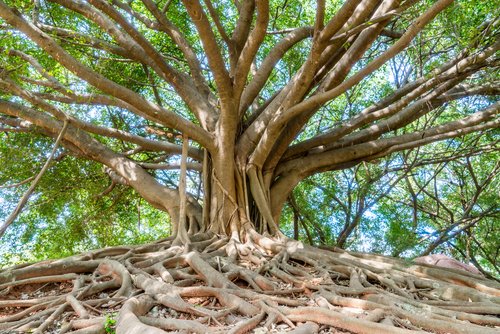
The Banyan tree’s crimson fruit is seldom edible. Only during times of famine do people turn to consume it. Although the leaves can be finished to some extent, they are frequently used as plates and for wrapping food. Foods cooked over a fire can also be flavored with the leaves.
Banyan tree cultivation in your garden
A banyan tree takes a lot of work to flourish in any garden. A banyan tree is a difficult plant to grow, whereas the oak tree looks after itself. It is because it requires a large amount of space to grow and labor-intensive cultivation. An optimal environment is crucial throughout the early stages of growth. Therefore, if want to grow the tree, make sure you have plenty of room.
Majestic Banyan: A tree of legends
In many cultures, the tree is considered holy and is associated with protection, longevity and security.
Shelter of the Banyan: A natural oasis
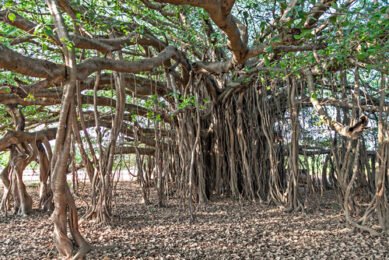
An old Banyan tree
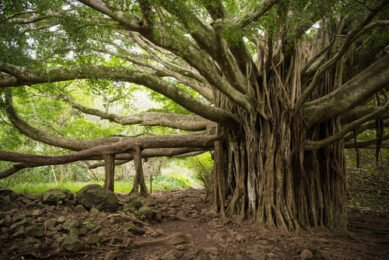
An old Banyan tree

Banyan’s Legacy: An enduring symbol
In Hinduism, the tree is considered the symbolic representation of Lord Brahman, Lord Vishnu and Lord Mahesh.
FAQs
What makes a banyan tree unique?
The lifespan of a banyan tree is how long?
The banyan tree is thought to live between 200 and 500 years. The oldest known banyan tree is around 250 years old and can be seen in a botanical garden in Kolkata.
How was the name of the banyan tree derived?
Originally given to F. benghalensis, the name originates from India. Early European explorers noted that Banyans/ Baniyas frequently gathered in the tree's shade.
What is the world's most enormous banyan tree?
The Great Banyan can be seen in the Acharya Jagadish Chandra Bose Botanical Garden in Howrah, a city close to Kolkata. One of nature's wonders of the world, the garden is made up of one enormous tree that covers 3.5 acres and stands more than 80 feet tall.
| Got any questions or point of view on our article? We would love to hear from you. Write to our Editor-in-Chief Jhumur Ghosh at [email protected] |
Priya Banerjee, a writer with a keen eye on the property market, she deciphers the ever-changing trends in residential real estate. Priya excels at simplifying complex real estate terms, making them easy for everyone to understand. Her well-researched advice helps buyers and investors understand complex topics.
